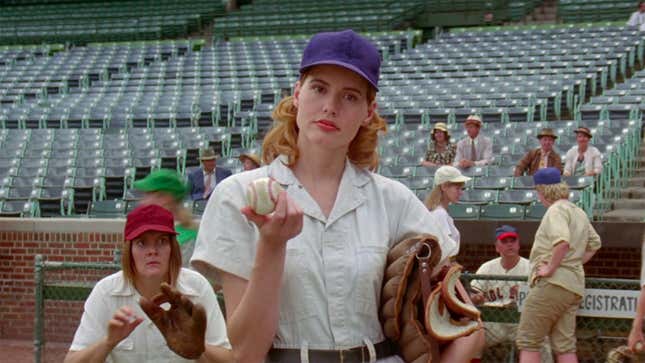

Before we begin, I must get this out of the way (clears throat): Batter up…
That’s better. Ever since I rewatched A League of Their Own last week (for the first time in over 10 years, maybe even closer to 20), “The All American Girls Professional Baseball League Song” has been in my head. So here’s a gift, from my head to yours.Look, A League of Their Own is as close to perfect as slick summer popcorn fare gets. It is virtuosically paced, making its two-hour-plus runtime feel like a brisk sprint around the bases. I can’t think of a movie with such a massive ensemble in which I legitimately care about the narrative arcs of like 10 characters. They’re so well drawn and played that even with a handful of traits, they’re indelible. Geena Davis (the epitome of Hollywood glamour even when smudged with baseball diamond dust), Lori Petty, and Tom Hanks as a lovable grouch in a proper supporting role (as the Rockford Peaches’ manager Jimmy Dugan, he literally supports the team of women at the center of this story). Most impressive in the performance realm is that this is a movie in which Madonna is legitimately good. Director Penny Marshall’s daughter, Tracy Reiner, plays Betty Spaghetti and while she has said repeatedly that she secured the role during a brief period when her mother wasn’t attached to the picture, I find that dubious and I still don’t care. I can’t imagine another Betty Spaghetti. Sometimes (apparent) nepotism works! A League of Their Own is a period piece whose historical setting is liberating instead of confining, and a political statement that avoids preaching and smarm. A League of Their Own just is, and it’s mostly wonderful.
It is the director’s job to create a universe, and with a maestro’s touch, Marshall conducted her ensemble in a highly specific and rarely visited world. In one of the archival extras on the most recent A League of Their Own Blu-ray release, Penny Marshall’s writer/director/actor Garry Marshall (who plays Walter Harvey, the chocolate baron who bankrolls the All-American Girls Professional Baseball League) said that in Hollywood, the prevailing understanding of the men in charge was that women’s mind frames were too narrow to make universally appealing blockbusters. The misogynist, untested supposition was refuted by Penny Marshall when her Big became the first movie directed by a woman to gross over $100 million at the box office in 1988. And then she did it again in 1992 with League, which was not just a hit, but a hit in which the female principal characters outnumber the men at something like a 4:1 ratio (at least) and play sports. (In the time between Big and A League of Their Own, Amy Heckerling’s Look Who’s Talking and Penelope Spheeris’s Wayne’s World also crossed the $100 million milestone.) One of League screenwriters, Lowell Ganz, recalled that prior to the movie’s release, it was considered a “huge potential fiasco,” which made its success that much sweeter.
-

-

-

-

-

-

-

-

-

-

-

-

-

-

-

-

-

-

-

-

-

-

-

-

-

-

-

-

-

-

-

-

-

-

-

-

-

-

-

-








































